11 Best HappyFox Alternatives of 2025

Table of contents
You’re likely familiar with HappyFox and its solid reputation in streamlining customer support. It’s a robust tool, no doubt. Still, your search for HappyFox alternatives suggests you’re on the lookout for something that might fit your specific needs better, a solution that aligns more closely with your business’s unique requirements and goals.
To help you actively seek the best tools that can help your team provide effective and amazing customer support, we’ve curated a list of possible Happyfox alternatives that can match your business requirements.
Table of Contents
- What is HappyFox?
- The Need for a HappyFox Alternative
- Top 11 Alternatives to HappyFox
- Upgrade to a better solution
What is HappyFox?
HappyFox is a cloud-based customer support and help desk software. It provides businesses with tools for ticketing, multi-channel support, knowledge base creation, and task automation. It allows organizations to manage customer queries and interactions across various channels like email, social media, and live chat.
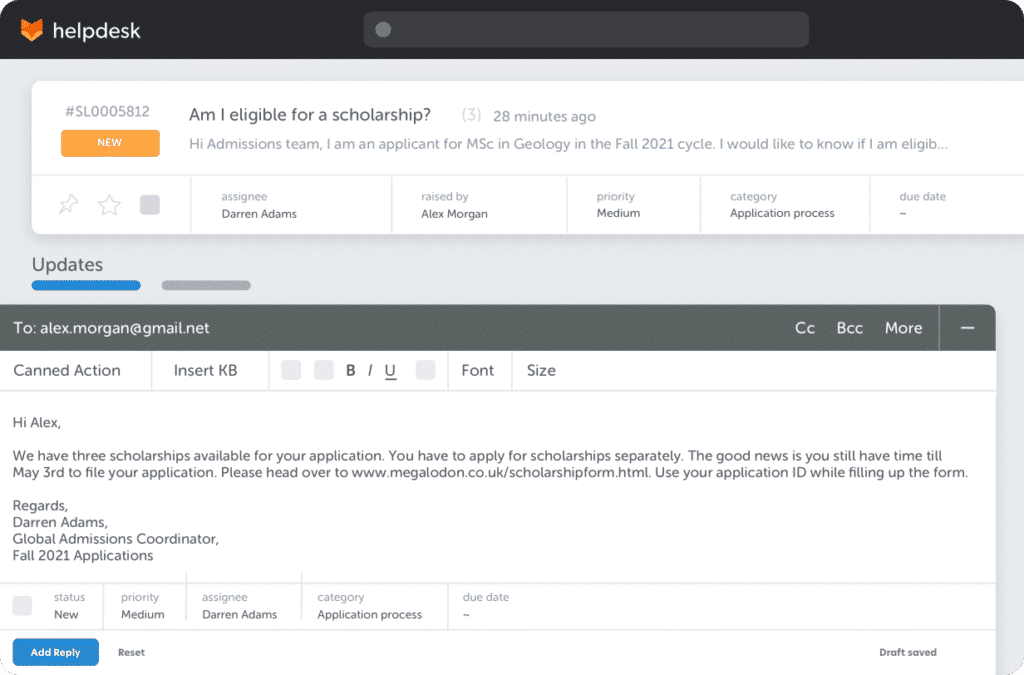
It’s known for its user-friendly interface, customization options, and ability to integrate with other business tools. The software is designed to help improve the efficiency and effectiveness of customer service teams in handling and resolving customer inquiries and issues.
The Need for a HappyFox Alternative
When considering alternatives to HappyFox, it’s important to understand some of the challenges or limitations users might encounter with this software. Here’s a list of common challenges associated with HappyFox:
- Cost: For small businesses or startups, the pricing of HappyFox can be a significant factor. Its cost might be higher compared to some other solutions, especially when considering additional features or higher-tier plans.
- Complexity for Small Teams: While HappyFox offers a wide range of features, smaller teams might find the platform somewhat complex or overwhelming, leading to a steeper learning curve.
- Customization Limits: Some users have reported limitations in terms of customization. While HappyFox is flexible, it might not meet the specific customization needs of every business.
- Integration Challenges: Although HappyFox integrates with various third-party applications, there may be limitations or challenges in integrating with certain specific tools or systems, which can be a hindrance for businesses relying on those tools.
- Limited Reporting Capabilities: Some users might find the reporting and analytics features less comprehensive than needed. Advanced reporting needs might not be fully met by HappyFox’s current capabilities.
- Mobile App Functionality: The functionality and user experience of HappyFox’s mobile app may not be as robust as its desktop version, which could be a drawback for teams relying heavily on mobile access.
- Customer Support Response Time: There have been instances where users experienced slower response times from HappyFox’s customer support, which can be a concern for businesses needing immediate assistance.
It’s important to note that these challenges can vary based on the specific context and needs of each business. What may be a limitation for one organization might not be an issue for another. Therefore, assessing these challenges against your own business requirements is crucial when considering HappyFox or its alternatives.
Top 11 Alternatives to HappyFox
Looking at HappyFox alternatives for 2025, we’re diving into different options to see which ones could match up well with what your business is looking for in customer support.
1. Help Scout
Help Scout stands out in the market for customer service software due to its emphasis on simplicity and features that are centered around the customer. It is tailored for companies that value easy-to-use support tools and a personal approach in their customer interactions. We’ll take a look at what Help Scout provides and compare it with HappyFox.
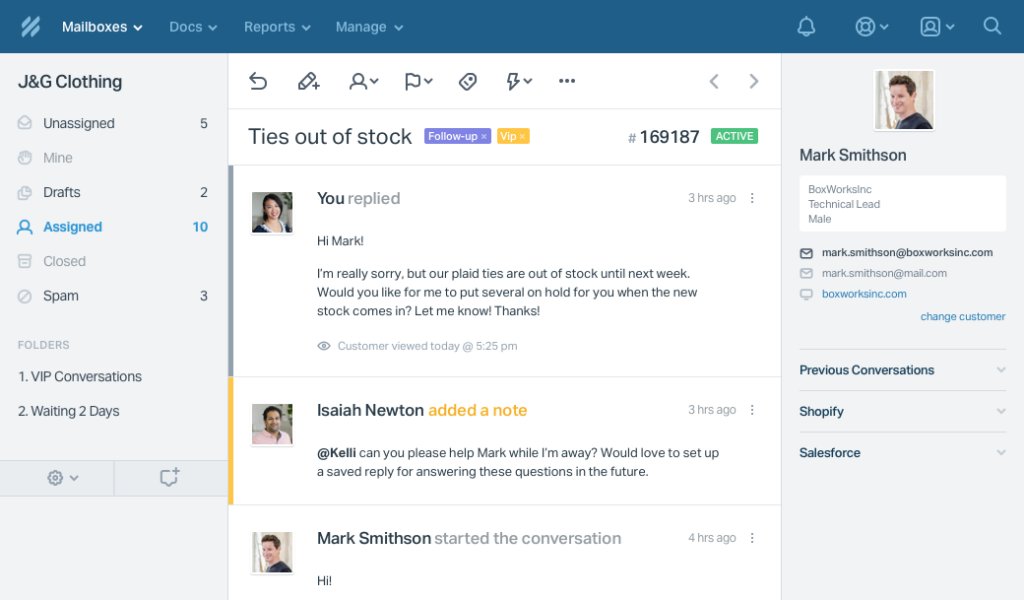
Pros of Help Scout:
- User-Friendly Interface: Noted for its straightforward and user-friendly design, which makes it simple for teams to get on board and utilize effectively.
- Customer-Centric Features: Provides various tools to enhance personal and effective customer interactions.
- Collaboration Tools: Offers superior collaboration capabilities, enabling teams to cooperate smoothly.
- Focused Functionality: Rather than offering a broad range of features, Help Scout concentrates on excelling in a few key areas.
Cons of Help Scout:
- Limited Integrations: Help Scout provides key integrations but might not have as broad a marketplace as HappyFox.
- No Native Social Media Support: In contrast to HappyFox, Help Scout doesn’t have native social media support.
- Feature Limitations: Certain advanced features and automations that HappyFox offers are not available in Help Scout.
Pricing:
Help Scout’s pricing is straightforward and tiered based on the features and scale:
- Standard: $20 per user per month, suited for small to midsize teams (billed annually).
- Plus: $40 per user per month, offering advanced features for larger teams (billed annually).
- Pro: $65 per user per month, tailored for large teams needing advanced security and service (billed annually).
Save over 40% by choosing Hiver over Help Scout
Is Help Scout better than HappyFox?
- Ticketing and Support: HappyFox offers advanced ticketing with extensive features, while Help Scout focuses on simplicity and ease of ticket management.
- Automation and AI: HappyFox excels in sophisticated automation and AI, compared to Help Scout’s basic automation geared towards personalized interactions.
- User Interface and Pricing: HappyFox has a more complex interface and higher pricing, whereas Help Scout is known for its user-friendly interface and affordability.
- Scalability and Integration: HappyFox is better suited for scalability and extensive integrations, in contrast to Help Scout’s appeal for smaller scale operations with simpler integration needs.
2. Hiver
Hiver is a Gmail-based, multi-channel customer service platform. This means teams using Hiver can set it up and have their support operations up and running within a few hours.
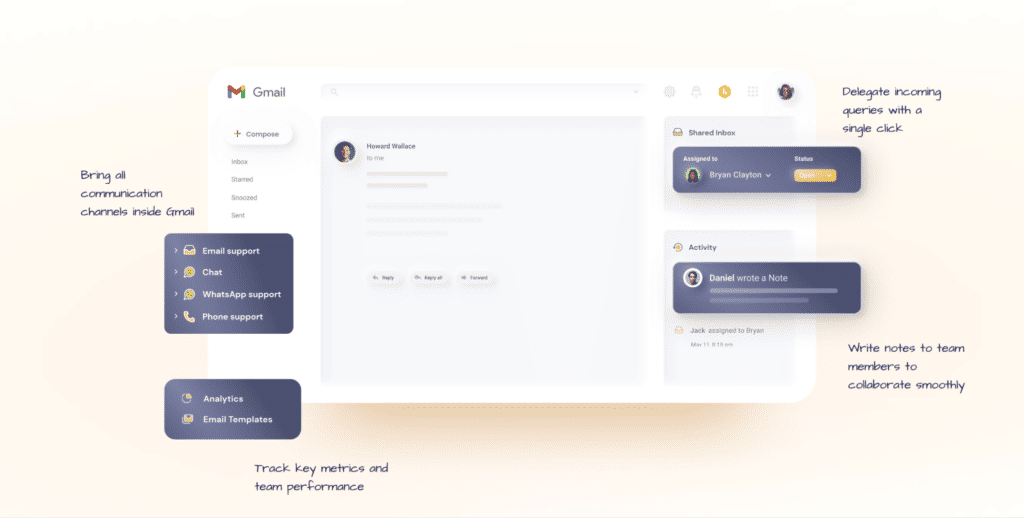
You save 20% with Hiver
| Critical Helpdesk Features | Helpdesk Tool | Small+Medium Teams (10 Users) | Large Teams (50 Users) |
|---|---|---|---|
Shared Inboxes Live chat Voice Channel Knowledge Base Automation Analytics and Reporting SLAs Integrations CSAT | Happyfox | $5,880/year | $29,400/year |
Hiver | $4,680/year | $23,400/year | |
Annual Savings | $1,200/year | $6,000/year | |
Annual Savings % | 20% | ||
When considering the differences between HappyFox’s Fantastic Plan to Hiver’s Pro Plan, two critical factors come into play:
- Budget-Friendly
- User-Friendly
Businesses can save 20% by choosing Hiver for HappyFox on comparable helpdesk features. The key advantage of using Hiver is that users have access to feature-rich helpdesk capabilities with a negligible learning curve.
This combination of cost savings and the convenience of using a familiar platform like Gmail makes Hiver an efficient choice for businesses focusing on budget-friendly and user-friendly customer support solutions.
Ease of Setup:
HappyFox is an alien interface that needs time to get used to. The users experience a learning curve in the setup process. Using Hiver, on the other hand, is pretty easy, mainly because it works inside Gmail. Because of this, people who know their way around Gmail can get the hang of Hiver in about 5 minutes. This is a lot quicker and simpler than the setup for many other customer support tools.
This easy setup is really helpful for teams that want to get going fast and don’t want to spend a lot of time learning to use software. Since Hiver builds on Gmail, which many are already familiar with, it cuts down on the usual hassle and delay when switching to a new system. This means teams can start focusing on delivering great customer service right away, without the stress of learning a whole new tool.
In-Depth Analytics:
Hiver’s analytics are really in-depth, giving a clear picture of how well customer service is performing. This is a big deal compared to HappyFox’s reports, which some people think only give a basic idea of support quality.
Hiver lets you get a detailed look at customer interactions. This helps businesses spot trends, see how well their teams are doing, and make choices based on solid data.
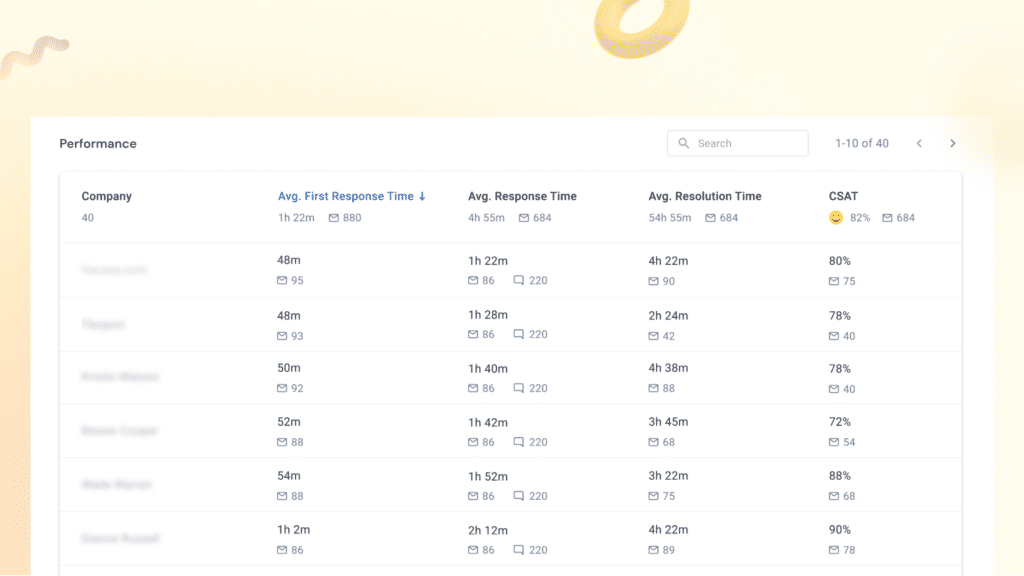
Hiver goes deep into analyzing how fast you respond. You can see not just your average response time, but also break it down like this:
- First response: How long it takes first to get back to a customer’s question.
- Next response: How long it takes to answer a customer’s follow-up message.
- Periodic response: How long it takes to send another email if the customer hasn’t replied yet.
This kind of detailed reporting is important for businesses that want to keep getting better at customer service and understand how their support affects customer happiness.
Multi-channel support:
Hiver stands out with its budget-friendly pricing and minimal learning curve. It enables support teams to:
- Effortlessly manage email tickets
- Tackle live chat inquiries
- Create and update a knowledge base
- Address queries through WhatsApp
- Conduct and accept customer calls (through integration with Aircall)*
…all while staying within the Gmail interface.
*The voice call integration feature is part of Hiver’s Pro plan (beginning at $49 per user per month). The best part about Hiver is that it offers a free plan. You can use the platform to manage your customer support function, at zero cost. The other omnichannel capabilities mentioned are available in the Lite plan (starting at $19 per user per month).
Vendor Support:
Hiver’s approach to customer support is one of its standout offerings. By ensuring uninterrupted, 24×7 support across all its plans, Hiver ensures that users have access to assistance whenever needed. This level of support, highlighted by its rapid response time, contrasts sharply with some of the frustrations expressed by HappyFox users, who occasionally report unreliable and slow support.
The ability to receive timely and effective help not only enhances the user experience but also ensures that any issues impacting customer service can be swiftly addressed, thus maintaining a high level of service continuity and customer satisfaction.
Customer support availability at HappyFox is limited across live chat and email on their “Mighty” and “Fantastic” plans.
3. Zendesk
Zendesk specializes in customer service software, offering a cloud-based collection of tools aimed at enhancing customer support and boosting customer engagement. Their primary offering is a help desk platform that helps businesses handle customer interactions across multiple channels, including email, phone, chat, and social media.
The Zendesk platform usually features elements such as ticketing systems, knowledge bases, and community forums. These components are integrated to simplify support workflows and offer a cohesive perspective of customer interactions.
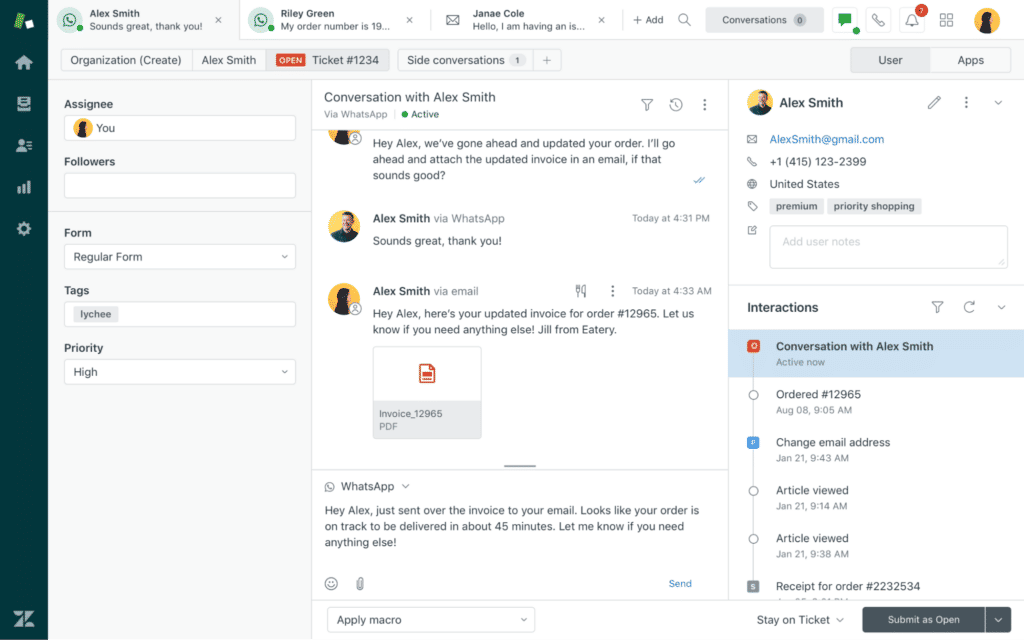
Additionally, Zendesk provides tools for analytics and reporting, enabling businesses to monitor performance indicators and obtain insights into customer contentment and the effectiveness of their support operations.
Pros of Zendesk:
- Extensive Multichannel Support: Zendesk excels in offering support across multiple channels like email, web, social media, and phone from a single dashboard, which might be more comprehensive than HappyFox’s offerings.
- Advanced AI and Automation: Zendesk’s use of AI, particularly with its Answer Bot powered by machine learning, provides quick and efficient responses to customer queries, possibly outperforming HappyFox in automated customer support.
- Greater Customization Options: Zendesk boasts a wide array of apps and integrations in its marketplace, allowing for more tailored user experiences than what might be available with HappyFox.
- Robust Analytics and Reporting: Zendesk provides a comprehensive suite of analytics tools, offering deeper insights into customer satisfaction and agent performance, which could be more detailed compared to HappyFox’s analytics capabilities.
Cons of Zendesk:
- Learning Curve: New users may find Zendesk’s extensive features more challenging to master than HappyFox’s platform, leading to a steeper learning curve.
- Higher Cost: Zendesk can be more expensive, especially when considering its range of features, add-ons, and premium options, compared to HappyFox’s pricing structure.
- Complexity in Navigation: The platform’s complexity might require more time and effort to train staff effectively than HappyFox, which is often seen as more straightforward.
- Need for Technical Expertise in Customization: Fully utilizing Zendesk’s customization options often requires technical skills, which might be more demanding than the customization process in HappyFox.
Pricing:
The pricing for the Zendesk Suite package is structured into different tiers, offering a range of features that accommodate businesses from small to large enterprises. Below are the pricing details for each tier, both on an annual and monthly subscription basis:
- Suite Team: The annual subscription cost is $55 per agent per month, while the monthly subscription is $69 per agent per month.
- Suite Growth: The annual subscription is priced at $89 per agent per month, and the monthly subscription comes in at $115 per agent per month.
- Suite Professional: For an annual subscription, the cost is $115 per agent per month. If you opt for a monthly subscription, the cost is $149 per agent per month.
- Suite Enterprise: The annual subscription rate is $169 per agent per month, while the monthly subscription is $219 per agent per month.
Zendesk costs 2x more than Hiver
Is Zendesk better than HappyFox?
Integration Capabilities:
- Zendesk offers a vast array of integrations with various third-party applications, which might be more extensive than HappyFox.
- HappyFox, while providing essential integrations, may have a more limited range compared to Zendesk’s extensive marketplace.
User Interface and User Experience:
- Zendesk’s interface, while feature-rich, can be more complex and might require a longer adjustment period for users compared to HappyFox.
- HappyFox is often praised for its user-friendly interface, which could be more straightforward and easier for new users to navigate than Zendesk’s.
Support and Training:
- Zendesk provides a wide range of support options and training materials, which can be more comprehensive than HappyFox’s offerings.
- HappyFox, with its simpler platform, may require less intensive support and training, potentially making it a more accessible option for smaller teams or businesses.
Target Market and Focus:
- Zendesk is designed to cater to a wide range of businesses, from small startups to large enterprises, with a focus on scalability and extensive features.
- HappyFox may be more focused on providing efficient and straightforward solutions, particularly appealing to small and medium-sized businesses looking for an easy-to-use platform.
Customization for Specific Needs:
- Zendesk allows deep customization but requires technical skills to fully leverage these features, potentially posing a challenge for businesses without in-house technical expertise.
- HappyFox offers customization but typically in a more user-friendly manner, which may not require the same level of technical knowledge as Zendesk.
4. Salesforce Service Cloud
Salesforce Service Cloud is a comprehensive customer relationship management (CRM) platform, notable for its broad array of features and scalability. It is primarily designed for larger enterprises and organizations that require an all-encompassing solution for managing customer service, sales, and marketing. Equipped with advanced AI capabilities and a variety of integration options, Salesforce Service Cloud is commonly chosen by businesses seeking a customizable and scalable service platform.
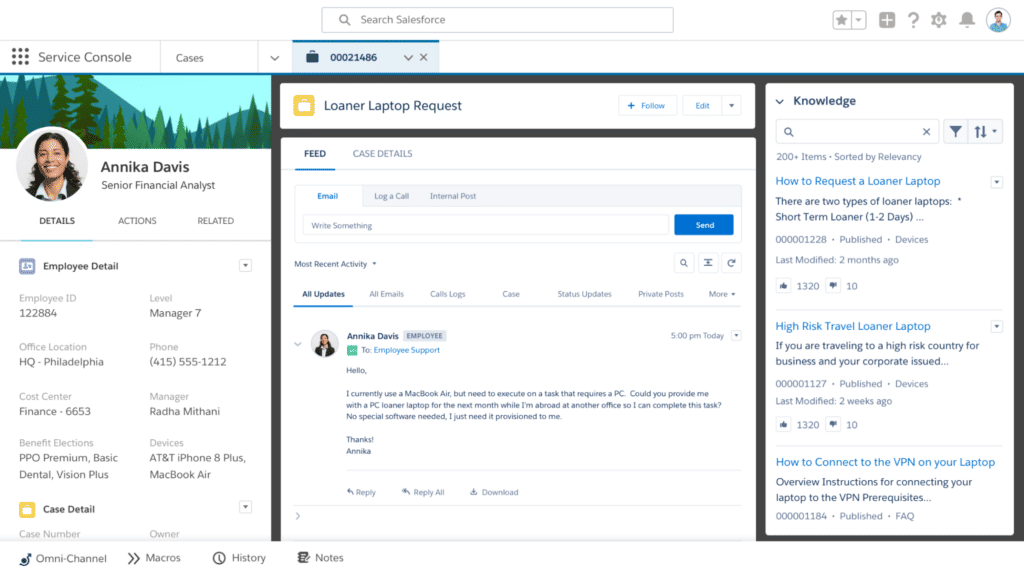
Pros of Salesforce Service Cloud:
- Advanced AI and Analytics: Incorporates AI-driven insights and analytics to enhance customer service.
- Highly Customizable: Offers extensive customization options to fit the specific needs of businesses.
- Scalability: Well-suited for large enterprises due to its ability to handle high volumes of customer interactions.
- Comprehensive Integration: Seamlessly integrates with other Salesforce products and a wide range of third-party applications.
Cons of Salesforce Service Cloud:
- Feature-Rich Interface: The abundance of features might be daunting, necessitating a considerable investment of time to master.
- Elevated Pricing: Often pricier than other options, potentially limiting its accessibility for smaller enterprises.
- Demanding in Resources: Needs more resources and technical expertise for effective implementation and ongoing management.
Pricing:
Salesforce Service Cloud offers several pricing tiers, billed annually:
- Starter: $25 per user per month.
- Professional: $80 per user per month.
- Enterprise: $165 per user per month.
- Unlimited: $330 per user per month.
- Unlimited+: $500 per user per month.
Is Salesforce Service Cloud better than HappyFox?
Target Audience and Scale:
- Salesforce Service Cloud is designed for larger enterprises and organizations, offering a comprehensive range of features suitable for complex, large-scale operations.
- HappyFox, on the other hand, tends to cater more to small and medium-sized businesses, focusing on providing efficient, user-friendly solutions.
Feature Set and Customization:
- Salesforce Service Cloud boasts a wide array of advanced features, including extensive AI capabilities and a myriad of integrations, making it highly customizable to meet diverse business needs.
- HappyFox provides essential customer support features and integrations, but may not match the depth and breadth of customization and advanced functionalities found in Salesforce Service Cloud.
Complexity and Usability:
- Due to its extensive features, Salesforce Service Cloud can be more complex and may require a significant amount of training and technical knowledge to navigate effectively.
- HappyFox is known for its straightforward interface and ease of use, potentially offering a quicker setup and easier adoption for teams without extensive technical expertise.
Pricing and Investment:
- Salesforce Service Cloud is generally more expensive, reflecting its extensive features and scalability options, making it a significant investment for large enterprises.
- HappyFox is likely to be more affordable, appealing to businesses with smaller budgets or those that do not require the high-level functionalities of larger CRM platforms like Salesforce.
Focus on CRM Integration:
- Salesforce Service Cloud is part of the broader Salesforce ecosystem, which is primarily focused on CRM, providing a holistic approach to customer service, sales, and marketing.
- HappyFox, while offering CRM integrations, primarily focuses on customer support functionalities and may not offer the same level of CRM integration and capabilities as Salesforce.
5. Zoho Desk
Zoho Desk is a customer support platform providing various tools to handle customer interactions. It’s a component of the larger Zoho suite of business apps, recognized for its ticketing, automation, and support across multiple channels.
Zoho Desk serves a wide range of customers, from smaller companies to larger corporations, providing varying degrees of functionality to accommodate different business sizes and needs.
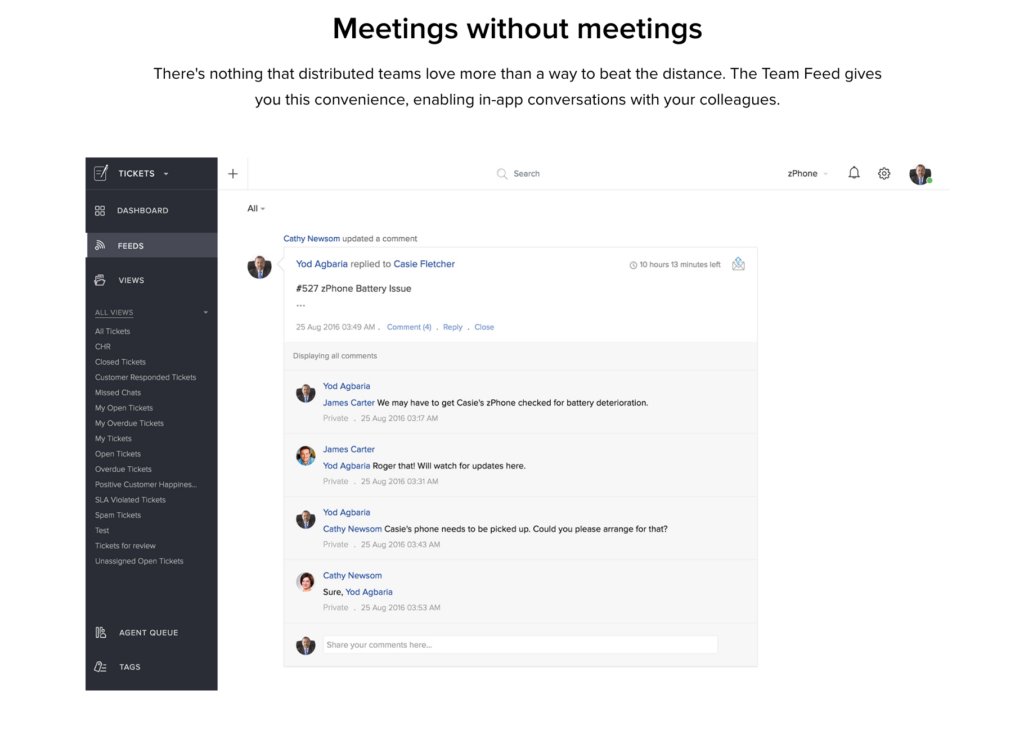
Pros of Zoho Desk:
- Broad Integration Capabilities: Zoho Desk seamlessly connects with other Zoho solutions and numerous external applications.
- Tailored Customization: The platform allows significant customization to suit diverse business needs.
- Artificial Intelligence Features: Zoho’s AI assistant, Zia, enables automation of common tasks and provides data-driven insights.
- Versatile Channel Support: Zoho Desk accommodates various communication methods, such as email, social media, and live chat.
Cons of Zoho Desk:
- Intricacy: The wide array of features and customization possibilities might be daunting for smaller teams or those new to this type of software.
- Adaptation Period: Given its extensive functionalities, users might need additional time to fully grasp and leverage all its features.
- Dependence on Integration: Although integration is advantageous, companies not utilizing other Zoho products might not experience the full benefits of Zoho Desk.
Pricing:
Here’s a breakdown of Zoho Desk’s pricing:
- Zoho Desk Express: $7 per user per month (billed annually) or $9 (monthly billing).
- Standard: $14 per agent per month (billed annually) or $20 (monthly billing).
- Professional: $23 per agent per month (billed annually) or $35 (monthly billing).
- Enterprise: $40 per agent per month (billed annually) or $50 (monthly billing).
Is Zoho Desk better than HappyFox?
Functionality and Features:
- Zoho Desk offers strong capabilities in ticketing, automation, and multi-channel support, as part of the broader Zoho suite of business applications.
- HappyFox also provides efficient ticketing and multi-channel support but may have different nuances in automation and integration capabilities compared to Zoho Desk.
Target Market:
- Zoho Desk caters to a diverse range of clients, from small businesses to large enterprises, offering scalable solutions that adapt to various operational scales.
- HappyFox is also versatile, serving both small and medium-sized businesses, with a focus on providing straightforward and efficient customer support tools.
Integration with Other Applications:
- Zoho Desk benefits from being part of the Zoho ecosystem, allowing seamless integration with other Zoho applications and tools, enhancing its functionality.
- HappyFox offers essential integrations but might not provide as extensive an ecosystem as Zoho Desk, focusing more on core customer support functionalities.
User Experience:
- Zoho Desk is known for its comprehensive feature set, which might require a slight learning curve for new users to fully utilize its capabilities.
- HappyFox is often praised for its user-friendly interface, potentially making it easier and quicker for new users to adapt and start using the software.
Pricing and Customization:
- Zoho Desk offers different levels of functionality at various price points, making it a flexible option for businesses of different sizes.
- HappyFox also provides various pricing tiers but the level of customization and advanced features may vary compared to what Zoho Desk offers, particularly at different pricing levels.
Discover the best Zoho Desk Alternatives
6. Intercom
Intercom is a platform for customer communication renowned for its capabilities in real-time messaging and customer engagement. It is distinguished in the market by its emphasis on enabling direct and immediate conversations between companies and their customers.
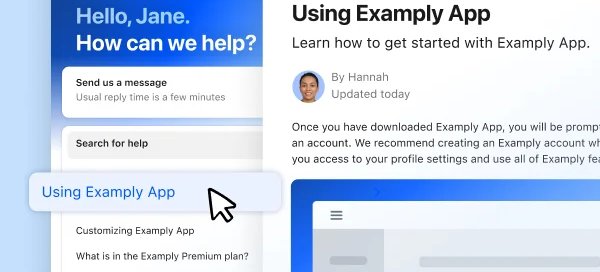
At the heart of Intercom’s offerings is a collection of tools that encompasses live chat, targeted messaging, and an advanced chatbot named the “Resolution Bot.” Utilizing artificial intelligence, this bot is crafted to provide automated replies and efficiently address common customer inquiries, thereby improving the support experience.
Intercom’s strategy merges these cutting-edge technologies with a strong commitment to personalization, utilizing customer data to customize interactions. The platform is designed to serve a broad spectrum of businesses, flexible enough to meet the needs of varying sizes and types of operations, from small startups to major corporations.
Pros:
- Instant Communication: Focuses on live chat features, enabling prompt communication with customers.
- Customized Customer Interaction: Leverages customer information to tailor conversations, improving the customer experience.
- Diverse Messaging Options: Equipped with various messaging choices, such as specific in-app messages and push notifications.
- Automated Responses and Chatbots: Delivers automated messaging and bots for efficient handling of routine inquiries.
- Strong Integration Features: Facilitates seamless integration with a wide array of business tools and applications.
Cons:
- Cost Considerations: May be costly for smaller businesses, particularly when expanding.
- Intricacy of Use: The platform’s wide range of features can make it seem complex to some users.
- Restricted Ticketing Capabilities: With an emphasis on messaging, the conventional ticketing system might not be as advanced as in other platforms.
Pricing:
Intercom’s pricing varies based on the usage and features needed:
- Starter Plan: Aimed at small businesses, with basic chat and messaging features.
- Growth Plan: Offers more advanced features suitable for growing businesses.
- Pro and Enterprise Plans: Includes full functionality and customization options, priced according to specific business needs.
Is Intercom better than HappyFox?
Real-Time Messaging and Engagement:
- Intercom is particularly known for its real-time messaging and engagement capabilities, focusing on direct and instant interactions between businesses and customers.
- HappyFox also offers communication tools, but its strengths may lie more in traditional ticketing and email-based support systems compared to Intercom’s real-time interaction focus.
Chatbot and Automation Technology:
- Intercom features the “Resolution Bot,” an advanced AI-powered chatbot designed to automate responses and handle common queries efficiently.
- HappyFox provides automation features but may not offer a chatbot with the same level of sophistication as Intercom’s AI-driven Resolution Bot.
Personalization and Use of Customer Data:
- Intercom emphasizes personalization in customer interactions, leveraging customer data to tailor conversations.
- HappyFox also values customer engagement but might approach personalization differently, potentially focusing more on the functionality of its support tools rather than data-driven customization.
User Interface and User Experience:
- Intercom offers a suite of tools that are integrated into a cohesive interface, emphasizing ease of use and immediate communication.
- HappyFox is known for its user-friendly interface, although its focus tends to be more on efficient ticket management and email support than on live chat interfaces.
Target Audience and Scalability:
- Intercom caters to a wide range of businesses, adaptable for various operational scales, from small startups to large enterprises.
- HappyFox also serves a diverse clientele, but its offerings may be more tailored to small and medium-sized businesses, focusing on straightforward, efficient solutions.
Pricing and Customization:
- Intercom’s pricing may reflect its advanced real-time messaging capabilities and AI technology, potentially placing it at a higher price point.
- HappyFox might offer more budget-friendly options, especially for businesses looking for essential support tools without the need for advanced real-time messaging or AI features.
Discover the Best Intercom Alternatives
7. Kayako
Kayako is a customer support solution that highlights the integration of various service channels into a cohesive system, suitable for businesses of all sizes. It’s designed for ease of use and to streamline customer support tasks, featuring an intuitive interface that brings together communications from emails, chats, and social media.
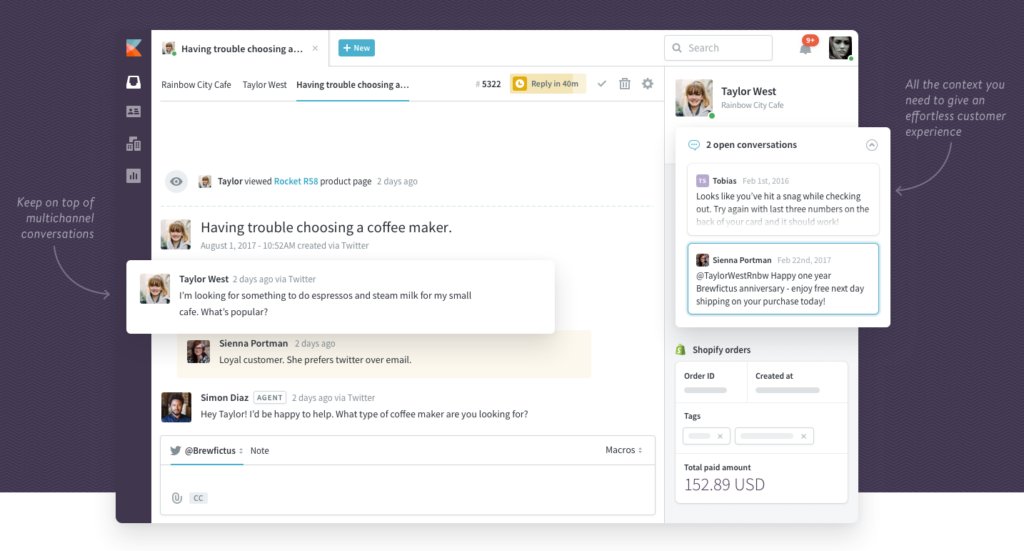
Important features of Kayako include adaptable workflows, which let businesses customize the platform according to their unique requirements, and detailed reporting tools for analyzing performance. In essence, Kayako strives to offer an uncomplicated, integrated approach to effectively manage customer interactions.
Pros of Kayako:
- Integrated Support Channels: Offers a unified platform for managing email, live chat, and social media interactions.
- User-Friendly Interface: Known for its intuitive design, making it easy for support teams to navigate.
- Customizable Workflows: Provides flexibility in setting up workflows to match specific business processes.
- Robust Reporting: Features comprehensive reporting tools to track and analyze customer support performance.
Cons of Kayako:
- Restricted Integration Options: Provides basic integrations, but not as comprehensive as those offered by competitors.
- Range of Features: Might not include some advanced functionalities present in other customer support platforms.
- Suitability for Scaling: Appropriate for small to medium businesses, but larger organizations may need more robust features.
Pricing:
- Inbox: $15 per agent per month – a shared email, chat, and social inbox for small teams.
- Growth: $30 per agent per month – customer service software for growing teams.
- Scale: $60 per agent per month – customer service software for larger teams and businesses.
- Enterprise: Starts at $100 per agent – a custom approach for larger companies.
Is Kayako better than HappyFox?
Channel Integration:
- Kayako emphasizes the integration of multiple service channels (emails, chats, social media) into a unified system, which can be particularly beneficial for businesses looking for a comprehensive communication solution.
- HappyFox also offers multi-channel support but may have different strengths or focus areas in terms of how these channels are integrated and managed within their platform.
User Interface and Accessibility:
- Kayako is designed with a focus on user accessibility, featuring a user-friendly interface that aims to simplify customer support processes.
- HappyFox is known for its straightforward and intuitive interface, with a similar goal of making customer support tasks easier and more efficient.
Customization and Workflow Management:
- Kayako allows for customizable workflows, enabling businesses to tailor the platform to their specific operational needs.
- HappyFox also offers customization, but the extent and approach to these customizations might vary, with each platform offering unique features and workflow options.
Reporting and Analytics:
- Kayako offers comprehensive reporting tools for performance analysis, which can be a significant advantage for businesses focused on data-driven decision-making.
- HappyFox provides reporting and analytics features as well, although the scope and depth of these tools might differ from what Kayako offers.
Target Market:
- Kayako caters to a wide range of business sizes, from small companies to larger enterprises, and is adaptable to different operational scales.
- HappyFox is similarly versatile, serving various types of businesses, but might be more tailored towards small to medium-sized businesses.
Overall Solution Approach:
- Kayako positions itself as a straightforward, integrated solution for managing customer interactions, focusing on ease of use and comprehensive channel management.
- HappyFox, while also aiming to streamline customer support, may place more emphasis on efficient ticket management and email support systems.
Discover the best Kayako Alternatives
8. Hubspot Service Hub
HubSpot Service Hub presents a customer service solution that seamlessly integrates with HubSpot’s CRM and marketing tools, striving to create a unified platform for customer engagement and support. It focuses on providing a holistic perspective of customer interactions and personalizes support by merging different business functions.
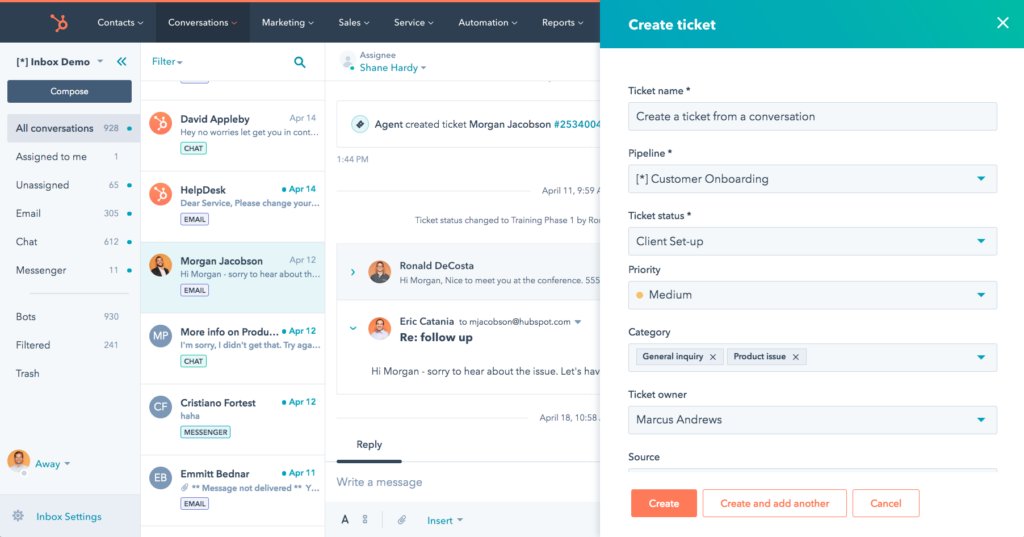
This platform is known for its easy-to-use interface and encompasses features such as ticketing systems, live chat, and knowledge bases. It is ideal for businesses seeking to centralize their customer service activities and is distinguished by its ability to work in tandem with other HubSpot services.
Pros:
- CRM Integration: Integrates effortlessly with HubSpot’s CRM, offering a consolidated perspective of customer interactions in sales, marketing, and services.
- Self-Service and Automation Features: Equipped with chatbots and knowledge bases, enabling customers to rapidly find solutions.
- Tailorable Support Features: The support ticketing system is highly adaptable to meet diverse business requirements.
- Insightful Reporting and Analytics: Offers sophisticated analytics to understand customer satisfaction and service performance.
- Intuitive User Interface: Recognized for its user-friendly layout, facilitating ease of adoption and use by teams.
Cons:
- Cost Consideration: Pricing may be relatively high, posing a challenge for small businesses or startups.
- Adaptation Period: The array of features might be daunting for newcomers, demanding time to fully understand.
- Reliance on Integrations: Maximizing the benefits of HubSpot Service Hub often involves integrating with other HubSpot tools, which could lead to additional expenses.
Pricing:
HubSpot Service Hub offers several pricing tiers:
- Free: Basic features with limited scope.
- Starter: Starts at $45 per month.
- Professional: Starts at $360 per month, offering more advanced features.
- Enterprise: Starts at $1,200 per month, providing the most comprehensive set of tools and analytics.
Is Hubspot better than HappyFox?
Integration with CRM and Marketing Tools:
- HubSpot Service Hub is closely integrated with HubSpot’s CRM and marketing tools, offering a comprehensive approach to customer engagement and support.
- HappyFox, while capable of integrating with various CRM systems, may not provide the same level of seamless integration with marketing tools as HubSpot.
Unified View of Customer Interactions:
- HubSpot emphasizes a unified perspective of customer interactions, aiming to personalize support by combining various business functions.
- HappyFox also focuses on centralizing customer interactions but might approach this with a different emphasis, possibly leaning more towards efficiency in ticketing and support management.
User Interface and Usability:
- HubSpot Service Hub is known for its user-friendly interface, which may be particularly advantageous for businesses looking for an easy-to-navigate customer service platform.
- HappyFox also offers a user-friendly interface, with an emphasis on straightforward ticketing and support processes.
Feature Set:
- HubSpot includes features like ticketing systems, live chat, and knowledge bases, integrated into its broader CRM and marketing ecosystem.
- HappyFox provides similar features but within a more focused scope, primarily concentrating on efficient customer support functionalities.
Target Audience and Business Needs:
- HubSpot Service Hub is designed for businesses that aim to integrate their customer service operations closely with CRM and marketing, providing a more holistic customer engagement experience.
- HappyFox is well-suited for businesses of various sizes looking for a focused and efficient customer support solution, especially those that prioritize streamlined ticket management.
Overall Approach and Integration with Other Services:
- HubSpot Service Hub is characterized by its integration with other HubSpot offerings, aligning customer service with broader business strategies.
- HappyFox, while offering integrations, may not have the same level of native connectivity with a broader business ecosystem like HubSpot.
9. Dixa
Dixa, is a versatile cloud-based platform for customer engagement, crafted to revolutionize business-customer interactions. It brings a personalized, human-centric touch to customer service by combining different communication modes – phone, email, chat, and messaging – into a unified platform. Perfect for companies that want to improve customer experiences through effective and integrated communications, Dixa is notable for its fresh take on engaging with customers.
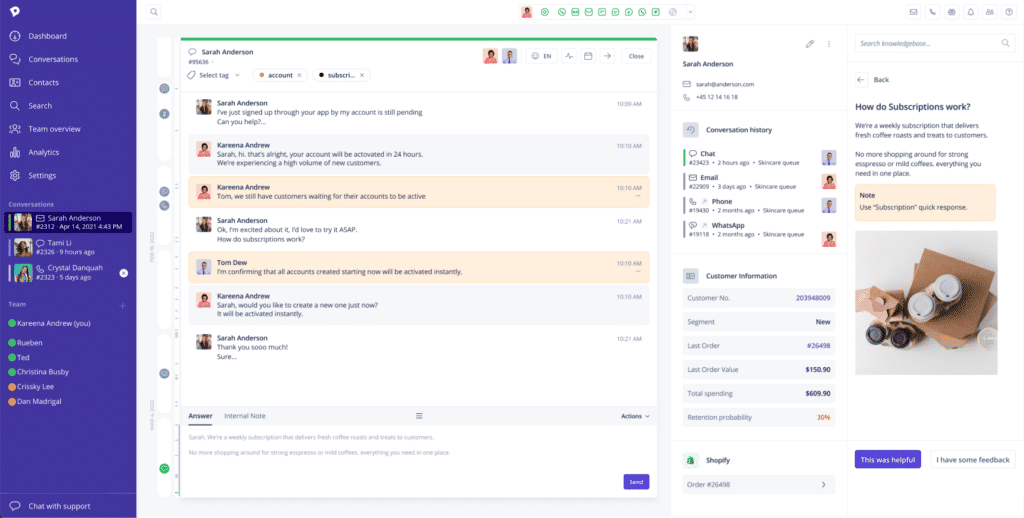
Pros:
- Comprehensive Channel Support: Delivers an authentic omnichannel experience, enabling fluid transitions between communication channels in ongoing conversations.
- Personalized Customer Service: Features advanced customer recognition technology for tailored services.
- Instant Performance Insights: Offers up-to-the-minute data on support team effectiveness and customer contentment.
- Growth-Friendly Scalability: Ideally structured for expanding businesses, thanks to its adaptable infrastructure.
- Automated and AI-driven Features: Incorporates tools for automation and artificial intelligence to optimize workflows and customer engagements.
Cons:
- Intricacy: The extensive features and integration options might be challenging for users to grasp at first.
- Pricing: Tends to be pricier than various alternatives, which could be a concern for smaller enterprises.
- Integration Hurdles: Although it boasts a wide array of integrations, setting them up and ensuring their functionality can be problematic for some users.
Pricing:
Dixa’s pricing is structured into several tiers, each catering to different business needs and sizes:
- Essential Plan: This is the starting plan, priced at $39 per agent per month. It is designed to provide the basic service essentials required to engage and build a customer base.
- Growth Plan: Aimed at businesses looking to scale and offer more personalized service, this plan is priced at $89 per agent per month.
- Ultimate Plan: This tier includes advanced automation and Knowledge-Centered Service, aimed at creating lasting customer loyalty. It is priced at $139 per agent per month.
- Custom Plan: Dixa also offers a Custom plan tailored to specific business needs. For this plan, businesses need to contact Dixa for pricing details.
These pricing tiers allow businesses to choose a plan that aligns with their scale of operations and specific customer service requirements, from basic essentials to more advanced and personalized customer engagement strategies.
Dixa Comparison with HappyFox:
Integration of Communication Channels:
- Dixa is known for integrating various communication channels like phone, email, chat, and messaging into a single, seamless platform, focusing on unified communications.
- HappyFox also offers multi-channel support, but the level and nature of integration across these channels might differ from Dixa’s approach.
Personalized Customer Service Approach:
- Dixa emphasizes a personalized and human approach to customer service, aiming to transform how businesses interact with their customers.
- HappyFox, while focusing on efficient customer service, might have a different emphasis in its approach to personalization and human interaction.
Platform Versatility and Innovation:
- Dixa stands out for its innovative approach to customer engagement, often seen as dynamic and adaptable to various customer service scenarios.
- HappyFox is recognized for its straightforward and efficient customer support solutions, potentially being more focused on traditional support systems.
Target Audience and Business Objectives:
- Dixa is ideal for businesses looking to enhance customer experiences with efficient, unified communications, especially those prioritizing a blend of different communication channels.
- HappyFox is well-suited for organizations of various sizes seeking a reliable and user-friendly customer support platform, especially if the focus is more on ticket management and email support.
Overall Customer Engagement Strategy:
- Dixa’s platform is designed to revolutionize the way businesses interact with customers, integrating multiple channels for a more cohesive experience.
- HappyFox provides robust customer support but may lean more towards streamlining and simplifying customer interactions rather than integrating diverse communication methods.
10. LiveAgent
LiveAgent is a customer support software that combines multiple communication channels such as email, live chat, social media, and phone calls into one unified interface. Originally created as a live chat system, it has grown into a full-fledged customer service platform, providing features like ticketing and social media support.
The platform is tailored for businesses that are in search of an all-in-one solution to organize and simplify their customer support activities.
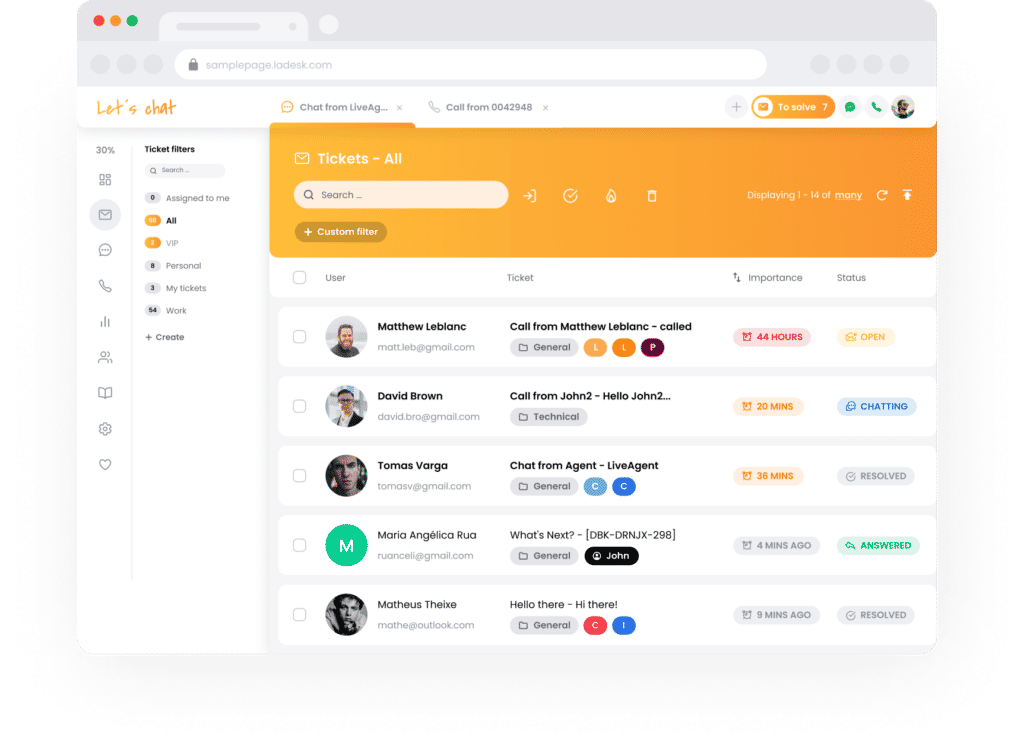
Pros:
- Comprehensive Channel Support: LiveAgent brings together inquiries from email, live chat, social media, and phone calls in one platform, simplifying customer interaction management.
- Effective Live Chat Capabilities: Renowned for its live chat feature, LiveAgent enables instantaneous support, enhancing customer satisfaction and involvement.
- Sophisticated Ticketing Mechanism: Boasts an advanced ticketing system capable of automating and optimizing support tasks for greater efficiency.
- Extensive Customizability and Integration: Allows for a high level of customization and smoothly integrates with a wide range of external applications.
- Continuous Support Availability: LiveAgent offers 24/7 customer support, ensuring help is always accessible.
Cons:
- Adaptation Time: New users might need considerable time to get accustomed to the wide array of features.
- Cost Implications: LiveAgent tends to be costlier than several other options, which may affect small businesses or startups.
- User Interface Experience: The design of the interface might seem less user-friendly and a bit dated, especially when compared to newer platforms.
Pricing:
LiveAgent offers a tiered pricing structure:
- Free Version: Basic functionalities with limited ticketing features.
- Ticket Plan: Focused on the ticketing system, starting from $15 per agent/month.
- Ticket+Chat Plan: Adds live chat capabilities, starting from $29 per agent/month.
- All-Inclusive Plan: Offers full features, including social media integration, starting from $39 per agent/month.
Is LiveAgent better than HappyFox?
Integration of Communication Channels:
- LiveAgent integrates a variety of communication channels, including email, live chat, social media, and phone, into a single interface, initially starting as a live chat solution but expanding to a more comprehensive tool.
- HappyFox also offers multi-channel support but may differ in the extent and manner of integration of these channels, with a possible focus on efficiency in ticket management and email support.
Functionality and Feature Set:
- LiveAgent provides functionalities like ticketing and social media support, evolving from its origins as a live chat solution to a full-service customer support platform.
- HappyFox offers similar functionalities but may have a different emphasis, possibly leaning more towards traditional support systems and streamlined processes.
Platform Evolution and Focus:
- LiveAgent began as a live chat solution and gradually expanded its capabilities, now offering a wide range of customer service tools.
- HappyFox, known for its user-friendly ticketing system, might focus more on simplicity and effectiveness in customer support rather than an extensive range of features.
Target Audience and Business Needs:
- LiveAgent is designed for businesses seeking an integrated solution to manage and streamline their customer support processes across various channels.
- HappyFox, while versatile, might cater more to businesses looking for a straightforward and efficient approach to customer support, particularly in ticket management.
Overall Approach to Customer Support:
- LiveAgent’s approach is to provide a comprehensive platform that covers a broad spectrum of customer support needs, from live chat to social media interactions.
- HappyFox focuses on delivering robust and user-friendly support solutions, potentially prioritizing ease of use and effective management over a wide array of features.
11. Groove
Groove is a customer support tool tailored to provide simple and effective service management, ideal for small to medium-sized businesses. The platform highlights an intuitive ticketing system and a user-friendly interface, designed to make the customer support experience more straightforward.
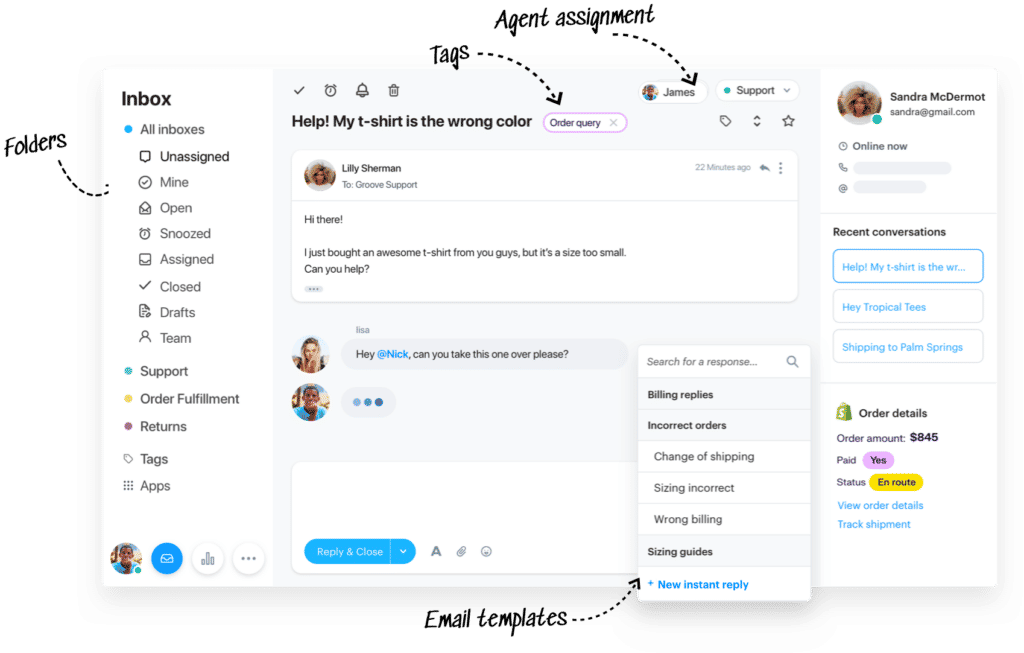
At its heart, Groove focuses on fundamental ticket management, collaborative tools, and the ability to build a knowledge base, offering key services while avoiding the intricacies of more complex systems.
Pros:
- User-Friendly Interface: Groove is notably easy to use, enabling teams to quickly adapt and utilize it with minimal training.
- Streamlined Ticketing: Provides an efficient, uncomplicated ticketing system for handling customer inquiries effectively.
- Team Collaboration Tools: Features elements like private notes and task assignments, fostering teamwork.
- Adaptable Knowledge Base: Offers the capability to create a detailed, customizable knowledge base for customer self-help.
- Key Integrations: Accommodates vital integrations with widely-used tools and services.
Cons:
- Basic Feature Set: Groove doesn’t have as many advanced functionalities, such as extensive automation and AI, found in more elaborate platforms.
- Growth Limitations: Ideal for small teams, Groove might not fully meet the scaling needs of larger organizations with more intricate requirements.
- Simplified Reporting Tools: Its reporting capabilities are fundamental, which may fall short for businesses seeking comprehensive analytics.
Pricing:
Groove offers a simple pricing structure:
- Starter Plan: Basic features suitable for small teams, priced at $12 per user/month.
- Plus Plan: More advanced features, including reporting and integrations, priced at $20 per user/month.
- Pro Plan: Full access to all features, priced at $35 per user/month.
Is Groove better than HappyFox?
Target Market and Business Size:
- Groove is specifically designed for small and medium-sized businesses, focusing on providing straightforward and efficient service management.
- HappyFox also caters to a similar market, including small and medium-sized businesses, but may offer a broader set of features that can also appeal to larger organizations.
User Interface and Ticketing System:
- Groove emphasizes a user-friendly ticketing system and an easy-to-navigate interface, aiming to simplify the customer support process.
- HappyFox is known for its intuitive interface and efficient ticketing system, making it similarly accessible and straightforward for users.
Core Functionality:
- Groove’s core functionality revolves around basic ticket management, collaboration tools, and knowledge base creation, targeting essential customer support needs.
- HappyFox offers a similar range of core functionalities but may include additional features or more advanced options in these areas.
Complexity and Feature Set:
- Groove provides essential services without the complexity of more advanced systems, making it a good choice for businesses seeking simplicity.
- HappyFox, while user-friendly, might offer a wider array of features, including more advanced options, catering to businesses that might require a more robust platform.
Overall Approach to Customer Support:
- Groove’s approach is centered on efficiency and ease of use, aiming to streamline the customer support experience for smaller businesses.
- HappyFox focuses on providing an efficient and effective customer support experience, potentially with a broader scope in terms of features and scalability.
Why Hiver is the best Groove Alternative
Upgrade to a better solution
While HappyFox is a strong and popular customer support platform, it’s important to understand that in the varied sphere of customer service software, one solution may not fit all scenarios. The process of finding an appropriate alternative should include a detailed analysis of your business’s specific needs, budgetary considerations, and growth plans.
By examining aspects such as distinct features, user experience, scalability, integration options, and the level of customer support offered, you can make a well-informed decision that bolsters your customer service operations.
Keep in mind, the objective is not just to switch from HappyFox, but to enhance or customize your customer support system in a manner that drives your business forward. Adopting this strategic approach ensures that your investment in a new system not only resolves your current issues but also supports your long-term goals for customer interaction and satisfaction.

































